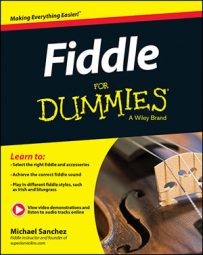Keeping your knuckles up means you have to have your hand high enough to be able to find every note on the fiddle without having to reach with your hand. Your hand should stay still as your fingers move.
When you start to put your fingers down on the D and A strings, you may find it easy to reach notes with your fingers. Don’t lower your knuckles because of this, though; eventually, you’ll have to play notes way over on the G string and then jump to the E string. You want to get your knuckles really high early on, so you can reach notes efficiently in the future.
The video in Chapter 6, Clip 16 and the following steps show how to achieve the perfect left hand position on the fiddle.-
Put on your shoulder rest and hold the fiddle without using your hands.
-
Place your thumb in the correct position.
Make sure your wrist is straight (don’t let it collapse in).
-
Make contact on the fingerboard.
Make sure you don’t let your thumb lift up along with your hand. You want the right side of your left hand to lift up slightly more than the left side.
-
Turn your hand inward while keeping everything else in the same spot.
This turn should make the far right side of your hand about 1 inch from the neck.
-
Curl your fingers without changing your hand position.
It’s all in the fingers!
The reason why knuckles up is emphasized so much is because it’ll seem a lot easier to you to dip your hand low and have flat fingers. This won’t make a big difference at first, but later it will make a huge difference in your playing speed and the accuracy of your finger placement. So you may as well do it correctly from the beginning!
It’s very easy to force your hand higher instead of your knuckles. That means you’d be painfully twisting your arm to create that extra height. This is very uncomfortable and not the way you should be doing it. Relax your hand and refer to the 85-15 rule. If you’re not relying on holding the neck with your hand, you should be able to raise it slightly without forcing your arm muscles into action.
Keeping your knuckles up is one of the hardest fundamentals to get used to at first, but within a few weeks, it will feel a lot more comfortable. After you get used to it, you won’t have to think about it as much in the near future. However, if you do it the wrong way from the beginning, it’ll be very hard to change.Before getting into actual placement of fingers, practice this technique for the next few days. Really get a feel for how your hand should form onto the neck of the fiddle. You want to have this fundamental down because it’s too easy to forget. Write a big note that says “KEEP YOUR KNUCKLES UP!” and put it on your violin case.

